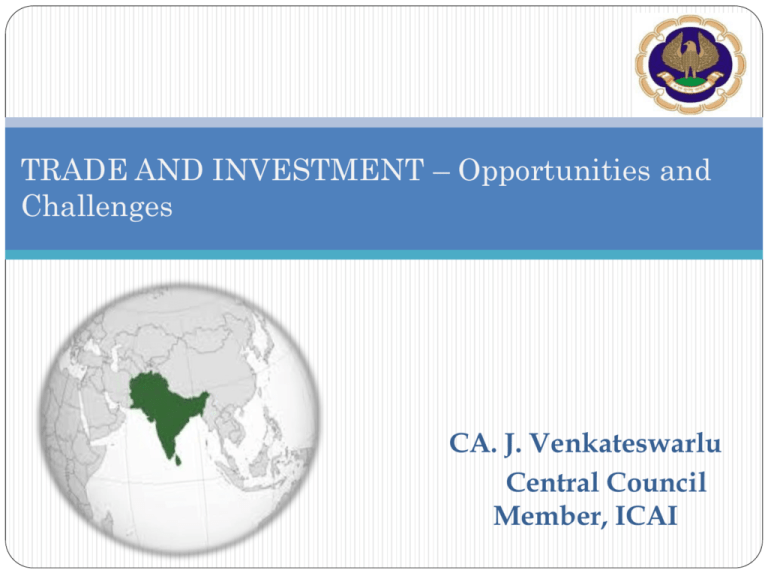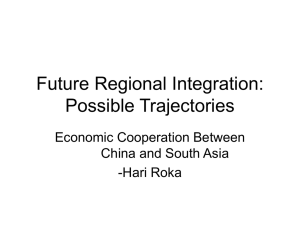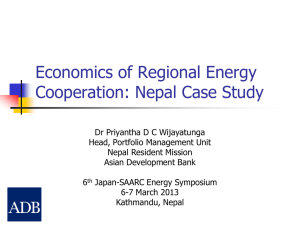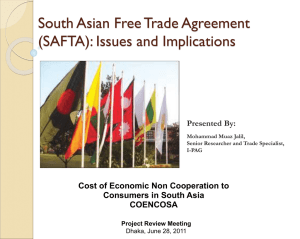South Asia - The Institute of Chartered Accountants of Pakistan
advertisement

TRADE AND INVESTMENT – Opportunities and Challenges CA. J. Venkateswarlu Central Council Member, ICAI Brief The South Asia Region, is among the developing regions of the world, accounting for about 24% of world’s population(40% of Asia’s population). The region falls short on most accounts like poverty, health, human development and education. Trade and investments are tools to make the region take long strides for the development of education, health infrastructure, reduction of poverty, prosperity among the region. The trade provides opportunity for people to people interaction, employment to youth, collaborate in sectors like infrastructure, energy, technology development etc. The regional trade has remain beyond its potential, which is and essential ingredient to the prosperity of the region. The Govt.’s, must work together to enhance the trade and investment across South Asia region ….. Trade & Investment Key to Fulfilling Billion Dreams, Billion Aspirations 2 SUSTAINING RAPID GROWTH IN SOUTH ASIA South Asia which includes eight countries - Afghanistan, Bangladesh, Bhutan, India, Maldives, Nepal, Pakistan and Sri Lanka, has made good progress on liberalizing trade regimes and cutting tariffs since the early 1990s when most of the countries started with reforms. The countries have also undertaken considerable industrial deregulation and other structural reforms. The governments and the private sector recognize that strong exports are critical for overall economic growth and poverty reduction and export-led growth has become a key thrust in each country. Each country has been integrating with the global economy, as evidenced by the significant increases in the merchandise trade [(exports plus imports)GDP] ratios. 3 SUSTAINING RAPID GROWTH IN SOUTH ASIA According to the World Bank report, in the last quarter of 2014, South Asia was already the fastest-growing region in the world. According to the twice-a- year South Asia Economic Focus report, regional growth is projected to steadily increase from 7 percent in 2015 to 7.6 percent by 2017 through maintaining strong consumption and increasing investment. 4 REGIONAL ECONOMIC INTEGRATION IN SOUTH ASIA Formation of SAARC, 1985 Recognition of complementarities – Committee on Economic Cooperation – Trade, Manufactures and Services study, 1991 Trade liberalization: SAPTA, 1994 SAFTA, 2004: Implementation time frame 2006-16 Bilateral FTAs: India-Sri Lanka Unilateral Afghanistan 5 preferences: India-Nepal, India-Bhutan, India- RTAs & INDUSTRIAL RESTRUCTURING SOUTH ASIA Encouraging results from limited experiences SAPTA: trade gains by smaller countries India-Sri Lanka FTA: expansion of trade with narrowing of trade deficit + diversification of SL export basket; Indian companies shifting production to Sri Lanka depending 6 upon the comparative advantage for exports to South Asia and rest of the world » e.g. Tyre industry Substantial FDI inflows from India to Sri Lanka Spurring third country investments in Sri Lanka Now upgrading FTA to CEPA CHALLENGES The cost of trading across borders in South Asia is one of the highest in the world. Cross-border trade is especially important for smaller countries and for landlocked provinces / countries, including Afghanistan, Bangladesh, Bhutan, Nepal, Northeast India and Northwest Pakistan. South Asian countries have maintained a higher level of protection within the region than with the rest of the world. 7 CHALLENGES Regional integration in South Asia has remained weak on all fronts. Even in the face of pressing needs, regional cooperation on water and energy, for instance, barely gets the kind of attention that it deserves. On trade, the story is even worse. Intra-regional trade in Asia (as a geographic block) constitutes around 56 percent of the total trade, whereas the South Asian intra-regional trade-share hovers below the five percent mark. If you consider the fact that about 40 percent of the total Asian population actually resides in South Asia, the scale of the anomaly becomes clearer. The mammoth bureaucracies of South Asia, the political leaders who rule the halls of power in South Asia, as well as the highly-organized yet helpless business associations in the South Asian capitals all agree that more needs to be done. It takes on average more than 33 days to export from South 8 Asia compared to 12 days from OECD countries and more than 46 days to import into South Asia compared to 14 days for OECD. CHALLENGES • Major barriers for intraregional trade in South Asia • Poor supply capabilities and infrastructure • Poor transport connectivity and trade facilitation • Lead to high trade costs within the sub-region • Trade costs for intraregional trade same as for trade with EU => benefit of geographical proximity not being exploited • • 9 Poor banking links and capital market contacts Movement of Skilled Professionals CHALLENGES South Asian exports lacks diversity in terms products and markets. The of import-substitution policies of South Asia worked toward limiting not just total trade but in some ways asymmetrically toward limiting intraregional trade. 10 CHALLENGES South Asia remains much less integrated into global manufacturing supply chains due to the low value-added nature of much of their exports and their lack of competitiveness with East Asian manufacturing hubs. This reflects a broad range of problems, including political uncertainties as well as the weak business climate and poor infrastructure. 11 CHALLENGES Individual South Asian nations have not been fundamentally averse to global and regional trade agreements. Beginning from South Asia’s own South Asian Free Trade Agreement (SAFTA) to global regimes such as WTO, the South Asian states have signed on the dotted line faster than they have mustered the commitment required to trade freely, including with their immediate neighbors. While the agreements themselves remain stuck at various stages of implementation, there almost appears to be an industry on overdrive dedicated to devising non-tariff barriers (NTBs) in all South Asian countries. That also lead to informal trade and third country trade Political tension in the region amongst the nations has hampered the growth of the internation as well as intra region trade. 12 OPPORTUNITIES 13 OPPORTUNITIES Trade within South Asia can be more than doubled if appropriate regional agreements on roads, rail, air, and shipping are put in place enabling seamless movement. 14 OPPORTUNITIES Garments exports remain a key contributor to the country's economic growth, despite challenges faced by the industry due to increased regulatory standards by international textile manufacturers. In order to boost the investment climate further, the government will need to further strengthen regulatory and safety standards for key sectors such as garments, as well as improving key infrastructure such as power, airports and railways. 15 OPPORTUNITIES The development of effective bilateral and multilateral trade will not only allow an increase in trade but also diversification of the types of goods traded. It will improve export competitiveness by allowing producers in one country to obtain unique, less costly, or better quality inputs from suppliers in neighboring countries. 16 OPPORTUNITIES 17 Annual trade between India and Pakistan, the bulk of which is routed through Dubai, is currently estimated at US$1 billion, but could be as great as US$9 billion if barriers are lifted. OPPORTUNITIES South Asian countries will benefit substantially from greater integration through energy trade, commerce and river basin management. The most obvious gains are in the power sector, with connectivity enhancing system reliability, lowering costs and carbon emissions, and relieving debilitating shortages in all countries by enabling the sustainable development of the enormous hydro and gas-based power generation potential of the Himalayas – the “water tower” of Asia – and of Central Asia. Afghanistan and Nepal have water resources that could potentially generate around 24,000 and 83,000 megawatts of electricity respectively. Transmission infrastructure, clean energy generation, and fair pricing agreements across borders hold the key to realizing this potential. 18 OPPORTUNITIES Trade between South Asian countries would likely grow substantially if they were to just open the borders to each other on a genuine Most Favored Nation (MFN) basis. Momentum for economic cooperation has been building in recent years and months. India and Pakistan have revitalized ministerial-level negotiations on expanded trade including through granting NonDiscriminatory Access – a similar status to Most Favored Nation (MFN) – to India, reciprocating India’s granting of MFN status to Pakistan a decade ago. India has modernized its Attari border post with Pakistan and has offered to export 500 megawatts of power. India and Bangladesh have enhanced their bilateral ties, including in power trade, and India has extended tariff-free access to its market to all Least Developed Countries in the region. Afghanistan and Pakistan have started implementing a transit and trade treaty which they signed in 2011. Indian investment in Sri Lanka has risen significantly, as has cross-country trade, following a 2001 Free Trade Agreements. 19 WORLD BANK PROJECTS 20 WORLD BANK PROJECTS & RESULTS 1. 21 Central Asia –South Asia (CASA) 1000 Electricity Transmission Project ($526.5m; Regional SARIDA: $280M) : CASA-1000 will facilitate electricity trade of 1,300 megawatts (MW) of existing summertime hydropower surplus between Kyrgyz Republic and Tajikistan in Central Asia and Afghanistan and Pakistan in South Asia. The project will generate valuable foreign exchange revenues to the Kyrgyz Republic and Tajikistan, and alleviate electricity shortages in Afghanistan and Pakistan during the peak summer season. It will also help establish Afghanistan’s role as a viable transit country. WORLD BANK PROJECTS & RESULTS 2. India Mizoram Road II Regional Connectivity Project (US $107m; Regional IDA $ 71.3m): The project is designed to increase transport connectivity along regional trade corridors in Mizoram. With road transport being the only mode of transport within the state of Mizoram, improvements to the network will reduce freight and passenger transport costs, and provide quicker and safer access to all parts of the state and to neighboring states and countries (Bangladesh and Myanmar). 22 WORLD BANK PROJECTS & RESULTS 3. Nepal – India Regional Trade and Transport Project (US $ 99m;Regional IDA $59.3m): The Project will facilitate efficient goods trade between Nepal and India by removing current policy, procedural, systems, and capacity and infrastructure constraints along the Kathmandu-Kolkata Corridor. The expected outcome as a result of project interventions is a reduction of transport time and logistics costs for Nepal’s international trade. 23 WORLD BANK PROJECTS & RESULTS 4. The Nepal –India Electricity Transmission and Trade Project (US$99m approved in FY11 with AF for US$39m in FY1; Regional IDA $66m) : The Project will support construction of a high voltage electricity transmission line between Nepal and India, capable of transmitting up to 1,000 MW of power and paving the way to relieving Nepal’s crippling power shortages and facilitating the development of Nepal’s hydropower potential. To be completed in 2016, this Nepal-India interconnection will complement a 500 MW interconnection between India and Bangladesh and, together with existing and planned connectivity between Bhutan and India, will create the physical infrastructure for sub-regional power trade. 24 WORLD BANK PROJECTS & RESULTS 5. Strengthening Regional Cooperation in Wildlife Protection APL Program (APL1: US$39m & APL2: US$2.25m; Regional IDA: $24.5m): The Project will assist participating governments in building shared capacity, institutions, knowledge and incentives to protect regional wildlife. Participating countries include Bangladesh and Nepal (APL1), and Bhutan (APL2). Collaboration with India, Sri Lanka and neighbors in East Asia in this partnership is being explored. 25 BEYOND SAFTA Expediting full implementation of SAFTA Services and investment liberalization Roadmap or a vision for further deepening South Asian Customs Union, and eventually to an economic community An integrated South Asia could be an important building bloc of an emerging broader Asian regional grouping New salience in the post-crisis world 26 In every CHALLENGE lives a great OPPORTUNITY - Jeffrey Benjamin 27 CONCLUDING REMARKS Reimagining South Asia as an economic gateway to Prosperity and Peace Thinking of South Asia as an economic gateway between East and Central Asia can bring large dividends. To do so, South Asia first has to connect within itself, and significantly reduce intra-regional trade costs which, on average, are 85% higher than those in East Asia. Improving internal connectivity means that trucks travel seamlessly between countries, using the most economical route between destinations with minimal waiting time for border clearance, among other things. 28 Current rules require most trucks to transfer loads at the borders. There are no major transit agreements across the region and most border checkposts enforce tedious inspections on both sides of the border. The Motor Vehicles Agreement signed between Bangladesh, Bhutan, India and Nepal in June 2015, intended to pave the way for a seamless movement of road traffic, is a very good initiative in this regard. CONCLUDING REMARKS Implementing a genuine free-trade agreement An effective free-trade agreement can unleash the power of a market of 1.7 billion people. The South Asian Free Trade Agreement (SAFTA) contains too many 'sensitive lists' that allow countries to impose high import tariff restrictions on neighbours. A well-functioning SAFTA and reduced costs of trade can lead to a 250% increase in intra-regional trade (simulation estimates). A unified market can unleash a powerful dynamic by attracting large and small investors, which would foster an even larger market and generate a more efficient and powerful distribution of production across the region, as countries and sub-regions begin to specialize. 29 CONCLUDING REMARKS Addressing real and perceived non-tariff barriers Doing so can reduce the non-quantitative costs of trade, which typically run quite high. These barriers include, but are not limited to, over-zealous regulations (or implementation of these) that aim to ensure quality and food safety, environmental protection, animal and plant health. If not addressed, they would shape misperceptions and exacerbate the trust deficit between countries. A transparent and impartial redress mechanism, drawing from Africa, can be very useful. 30 CONCLUDING REMARKS Catalysing private investment in the region Giving a boost to private investment, including intra-regional investment, can help realise the complementarities between trade and investment. Trade and investment go hand in hand. Foreign investment, in particular, can help improve technology and allow export diversification, and help create regional value chains (for example, one country supplies buttons, another the fabric, yet another the assembly of the garment, before it is finally shipped from a fourth country). In South Asia, on average, foreign investment is well below potential, and intra-regional investment even more so. For example, Indian Firms have invested over $75 billion in equity overseas, but only a small fraction of this has gone to the region. 31 South Asian countries should improve their investment climate and proactively seek large anchor investors, including those from within the region. By doing so, they will realise their economic potential, catalyse export diversification and develop regional value chains. CONCLUDING REMARKS Focusing on expansion of trade in services Expanding trade in services such as education, healthcare and tourism can not only increase total trade but also boost people-to-people contact that is critical to reducing the trust deficit between South Asian countries. To expand services trade within the region, easing visa rules and regulations--even incremental improvements such as granting multiple entry visas--could have a major impact. There is a vast informal network of goods and people moving across borders. Tourism could be a low-hanging fruit. Promoting tourism for a range of needs including medical care and cultural tourism will expand people-to-people contact. Similarly, exchange programs and regional educational institutions will also help to engage the large youth cohort, representing 45% of the population. 32 Education exchange is a particularly effective way to reduce misperceptions, and also produces eloquent ambassadors for the cause of South Asian regional integration. CONCLUDING REMARKS Multilateral framework is critical for all round development of the all the nations in the region Developing countries should participate effectively in the negotiations by leveraging the coalitions to not only respond to but also set the agenda South-Asian cooperation also useful for capacity-building Importance of adopting a vision for further deepening of SAARC economic integration Appropriate Time to work for Implementation of Kathmandu Declaration 2014 Critical in the post-crisis scenario and for playing its due role in Asia- wide economic integration 33






